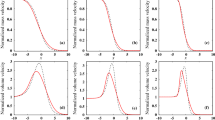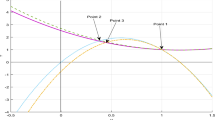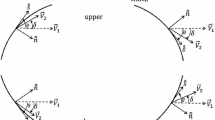Abstract
The Navier–Stokes (N–S) equations for a steady or unsteady, compressible, continuum flow are modified. The extension is based on a Stokesian fluid with a single nonlinear term in an isotropic stress, rate-of-deformation relation. This is the simplest possible nonlinear extension that also satisfies the second law of thermodynamics. The transport coefficient of this term is referred to as the third viscosity coefficient. In the extended version, the momentum and energy equations each contain a nonlinear term that is proportional to this new coefficient. These terms are significant only when the velocity gradient is extremely large. They are inconsequential, e.g., in a laminar boundary layer. Nevertheless, there are flows where the extended version of the N–S equations is relevant. The first of these is an ultrasonic, unsteady, one-dimensional flow, which is used for evaluating the bulk viscosity. In this case, the linearized N–S equations become singular as the ultrasonic frequency increases toward infinity. When the frequency is sufficiently large, nonlinear terms in the extended N–S equations need to be retained. The terms that are proportional to the third viscosity coefficient increase in importance, relative to linear terms, as the fourth power of the frequency. A second example is shock wave structure. A model is established and numerically solved for the normalized density derivative. Results are compared with corresponding measurements for argon when the upstream Mach number is 1.058 and 1.23. Good agreement between the extended N–S predictions and measurements is obtained for both Mach numbers with a single, but extremely small, value for the third viscosity coefficient. An important difference between conventional and extended N–S shock structure solutions is that the extended-model solution depends on the upstream pressure, whereas the conventional solution does not.


Similar content being viewed by others
References
Prangsma, G.J., Alberga, A.H., Beenakker, J.J.: Ultrasonic determination of the volume viscosity of \(\text{ N }_{2}\), CO, \(\text{ CH }_{4}\), and \(\text{ CD }_{4}\) between 77 and 300 K. Physica 6, 278–288 (1973)
Emanuel, G.: Bulk viscosity in the Navier–Stokes equations. Int. J. Eng. Sci. 36, 1313–1323 (1998)
Guggenheim, E.A.: Thermodynamics, pp. 64, 104. Interscience Publication, New York (1950)
Tisza, L.: Supersonic absorption and Stokes’ viscosity relation. Phys. Rev. 61, 531–536 (1942)
Vincenti, W.G., Kruger Jr, C.H.: Introduction to Physical Gas Dynamics. Wiley, New York (1965)
Bauer, H.J.: Phenomenological theory of the relaxation phenomena in gases. In: Mason, W.P. (ed.) Physical Acoustics, vol. II—Part A, pp. 47–131. Academic Press, New York (1965)
Hanley, H.J.M., Cohen, E.G.D.: Analysis of the transport coefficients for simple dense fluids: the diffusion and bulk viscosity coefficients. Physica 83A, 215–232 (1976)
Talbot, L., Sherman, F.S.: Structure of a weak shock wave in monatomic gas. NASA Memo 12–19-58W (1959)
Anderson, W.H., Hornig, D.F.: The structure of shock fronts in various gases. Mol. Phys. 2, 49–63 (1959)
Liepmann, H.W., Narsimha, R., Chahine, M.T.: Structure of a plane shock layer. Phys. Fluids 5, 1313–1324 (1962)
Hicks, B.L., Yen, S.-M., Reilly, B.J.: The internal structure of shock waves. J. Fluid Mech. 53, 85–111 (1972)
Alsmeyer, H.: Density profiles in argon and nitrogen shock waves measured by the absorption of an electron beam. J. Fluid Mech. 74, 497–513 (1976)
Garen, W., Synofzik, R., Wortberg, G., Frohn, A.: Experimental investigation of the structure of weak shock waves in noble gases. In: Potter, J.L. (ed.) Rarefied Gas Dynamics. Progress in Astronautics and Aeronautics, vol. 51, Part 1, pp. 519–528. AIAA, Reston (1977)
Fiscko, K.A., Chapman, D.R.: Comparison of Burnett, Super Burnett and Monte-Carlo solutions for hypersonic shock structure. In: Muntz, E.P., Weaver, D.P., Campbell, D.H. (eds.) Rarefied Gas Dynamics: Theory and Computational Techniques. Progress in Astronautics and Aeronautics, vol. 118, pp. 374–395. AIAA, Reston (1985)
Boillat, G., Ruggeri, T.: On the shock structure problem for hyperbolic system of balance laws and convex entropy. Continuum Mech. Thermodyn. 10, 285–292 (1998)
Simić, S.S.: Shock structure in continuum models of gas dynamics: stability and bifurcation analysis. Nonlinearity 22, 1337–1366 (2009)
Erwin, D.A., Pham-Van-Diep, G.C., Muntz, E.P.: Nonequilibrium gas flows. I: a detailed validation of Monte Carlo direct simulation for monatomic gases. Phys. Fluids A3, 697–705 (1991)
Eliott, J.P.: On the validity of the Navier–Stokes relation in a shock wave. Can. J. Phys. 53, 583–586 (1975)
Boyd, I.D., Chen, G., Candler, G.V.: Predicting failure of the continuum fluid equations in transitional hypersonic flows. AIAA Paper, 94-2352 (1994)
Reddy, J.N., Rasmussen, M.L.: Advanced Engineering Analysis. Sect. 1.5.13. R. E. Krieger Pub. Co, Malabar (1990)
Serrin, J.: Mathematical principles of classical fluid mechanics. Encyclopedia of Physics, vol. VIII/1. Springer, Berlin (1959). Sects. 59–61
Emanuel, G.: Analytical Fluid Dynamics, 2nd edn. CRC Press, Boca Raton (2001)
Hurewicz, W.: Lectures on Ordinary Differential Equations. Wiley, New York (1958)
Author information
Authors and Affiliations
Corresponding author
Additional information
Communicated by M. -S. Liou.
Appendix A: shock wave structure formulation
Appendix A: shock wave structure formulation
The non-dimensional governing equations for a perfect gas can be written as:
where
The upstream and downstream conditions are
Equation (7.3) can be integrated once, with the result
where the constant of integration is evaluated at state 1. Eliminate \(p\) in (7.4), and integrate once, to obtain
This result is (6.5a) for both the N–S and the extended N–S equations. By setting all derivatives equal to zero, it can be shown that the above two equations are consistent with (7.6, 7.7).
By replacing \(p\) in (7.8) with \(M_{1}T/u\), a cubic equation for \({\mathrm{d}}u/{\mathrm{d}}x\) is obtained.
The conventional N–S result is obtained by setting \(E\) equal to zero; the result has the form of (6.5b). An exact solution of the above cubic equation can be written as
which also has the form of (6.5b).
At the upstream state, set
To first order, \(a\) and \(b\) are
and \(A\) and \(B\) become
The final result is
By taking the ratio of these two quantities, a phase-plane analysis [23] yields a nondegenerate nodal point.
For the downstream singularity, set
To first order, \(a\) and \(b\) are
This yields
The \(\epsilon \hbox {s}\) are linearly transformed by [23]
with the result
The \(\lambda _\pm \) are the eigenvalues, and are given by
With the foregoing relations, initial conditions at the downstream state are
where \(\epsilon _u \) is set equal to \(10^{-4}\). The integration proceeds smoothly from \(\bar{{x}} = 0\), where \(\bar{{x}} = -x\).
Rights and permissions
About this article
Cite this article
Emanuel, G. Extended Navier–Stokes equations, ultrasonic absorption and shock structure. Shock Waves 25, 11–21 (2015). https://doi.org/10.1007/s00193-014-0538-z
Received:
Revised:
Accepted:
Published:
Issue Date:
DOI: https://doi.org/10.1007/s00193-014-0538-z




